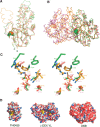Crystal structure of the probable haloacid dehalogenase PH0459 from Pyrococcus horikoshii OT3
- PMID: 16385007
- PMCID: PMC2242451
- DOI: 10.1110/ps.051922406
Crystal structure of the probable haloacid dehalogenase PH0459 from Pyrococcus horikoshii OT3
Abstract
PH0459, from the hyperthermophilic archaeon Pyrococcus horikoshii OT3, is a probable haloacid dehalogenase with a molecular mass of 26,725 Da. Here, we report the 2.0 A crystal structure of PH0459 (PDB ID: 1X42) determined by the multiwavelength anomalous dispersion method. The core domain has an alpha/beta structure formed by a six-stranded parallel beta-sheet flanked by six alpha-helices and three 3(10)-helices. One disulfide bond, Cys186-Cys212, forms a bridge between an alpha-helix and a 3(10)-helix, although PH0459 seems to be an intracellular protein. The subdomain inserted into the core domain has a four-helix bundle structure. The crystal packing suggests that PH0459 exists as a monomer. A structural homology search revealed that PH0459 resembles the l-2-haloacid dehalogenases l-DEX YL from Pseudomonas sp. YL and DhlB from Xanthobacter autotrophicus GJ10. A comparison of the active sites suggested that PH0459 probably has haloacid dehalogenase activity, but its substrate specificity may be different. In addition, the disulfide bond in PH0459 probably facilitates the structural stabilization of the neighboring region in the monomeric form, although the corresponding regions in l-DEX YL and DhlB may be stabilized by dimerization. Since heat-stable dehalogenases can be used for the detoxification of halogenated aliphatic compounds, PH0459 will be a useful target for biotechnological research.
Figures


References
-
- Aravind, L., Galperin, M.Y., and Koonin, E.V. 1998. The catalytic domain of the P-type ATPase has the haloacid dehalogenase fold. Trends Biochem. Sci. 23: 127–129. - PubMed
-
- Brunger, A.T., Adams, P.D., Clore, G.M., DeLano, W.L., Gros, P., Grosse-Kunstleve, R.W., Jiang, J.S., Kuszewski, J., Nilges, M., Pannu, N.S., et al. 1998. Crystallography & NMR system: A new software suite for macromolecular structure determination. Acta Crystallogr. D 54: 905–921. - PubMed
-
- Gouet, P., Courcelle, E., Stuart, D.I., and Metoz, F. 1999. ESPript: Analysis of multiple sequence alignments in PostScript. Bioinformatics 15: 305–308. - PubMed
Publication types
MeSH terms
Substances
Associated data
- Actions
LinkOut - more resources
Full Text Sources
Molecular Biology Databases

